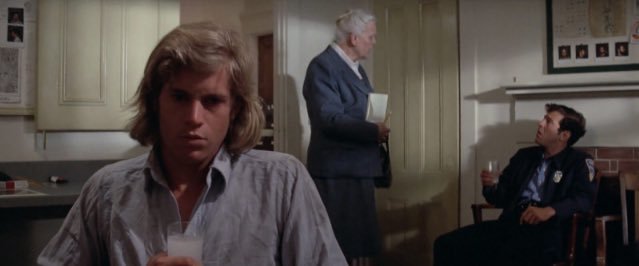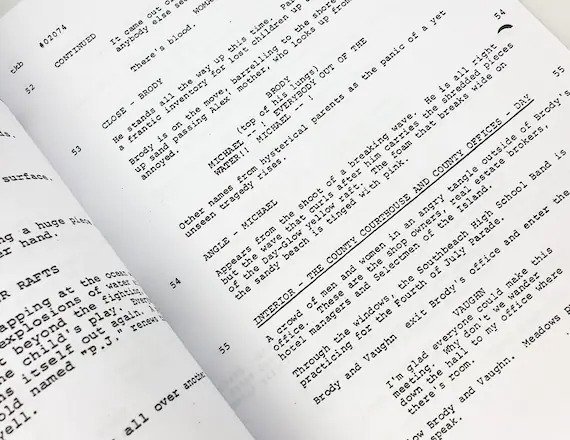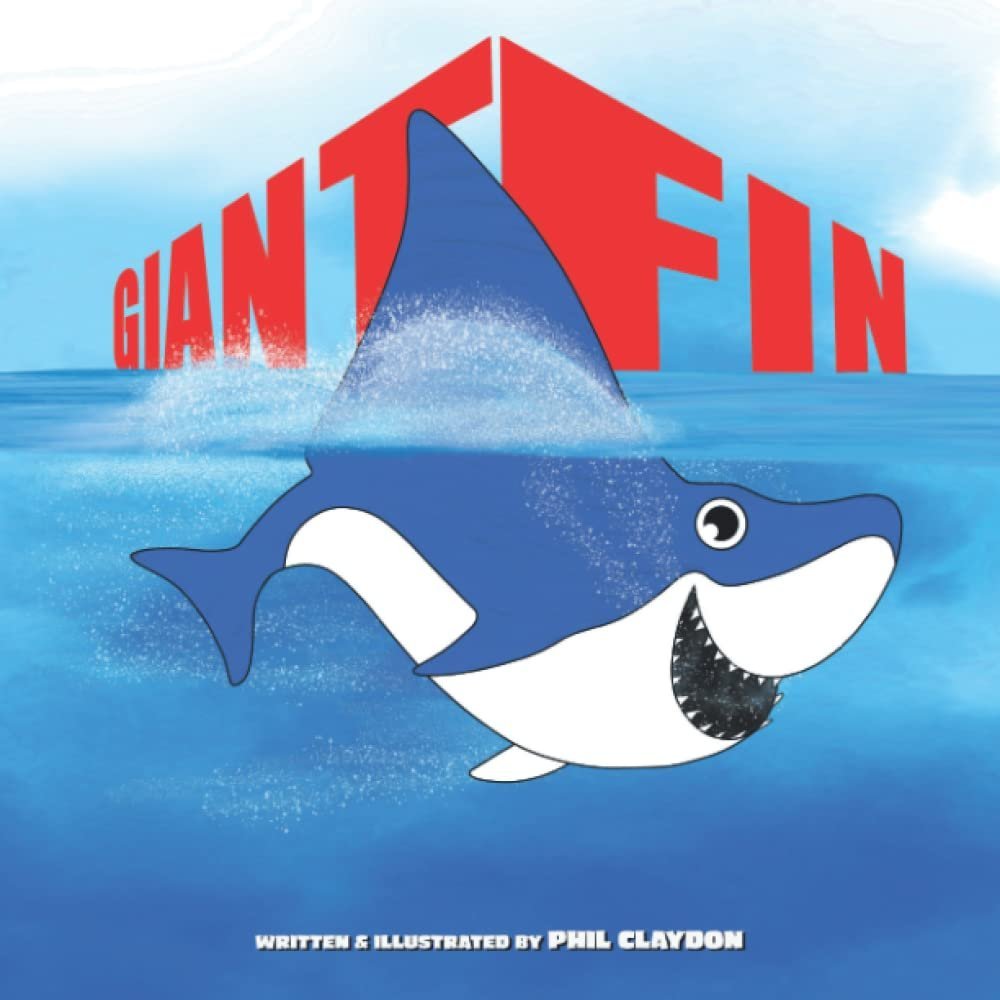YOUR SCREENPLAY: HOW TO WRITE IT LIKE JAWS
Jaws is the only film school you need. This is a statement I stand by.
You want to know how to masterfully block a scene with actors and a camera. Watch Jaws. You want to know how to construct suspense. Watch Jaws. You want to know how to connect audiences to characters. Watch Jaws.
And if you want to know how to write a screenplay. Watch Jaws.
Jaws is a perfectly engineered screenplay machine.
What do I find inspirational? The human moments and humour entwined in a propulsive structure.
These two harmonious elements are the key to this timeless classic. Spielberg’s skill has always been giving us extremely relatable characters in which to launch his audience into the fantastic. This is on full show in Jaws.
Most screenwriting tips always state the importance of your opening ten pages. Look at the first ten minutes of Jaws. It is a masterclass that encapsulates everything that works about Jaws.
The opening exchanges between Tom and the first victim Chrissie Watkins have humour as she runs ahead and he drunkenly tries to catch up he shouts.
TOM
I’m coming.
Chrissie pulls her top off. Getting naked. Ready to swim
TOM
I’m definitely coming.
He shouts, before falling head over heels down the sand dune.
This is followed by the first bite. The iconic opening hook that stuns the audience and leaves us thrilled, terrified and wanting more.
The introduction to Chief Brody. Groggy and hungover. The exchange with his Wife Ellen asking where the kids are, he replies;
BRODY
Probably in the back yard.
ELLEN
In Amity they say ‘Yahd’.
BRODY
They’re in the yard not too fah from the cah.
An important note for when you are writing a script, making sure your characters are always doing something in the scene.
Brody is answering the phone in response to the missing Chrissie Watkins. Ellen treats Michael who has cut himself on the swings. The scene is busy and everyone is in constant motion and doing something. The authenticity of a bustling home life switching between parenting and work duties. It is relatable.
Before we know it Brody is at the beach, where Chrissie’s remains are discovered.
But this horror is counteracted again by the Brody at the station, where Polly comes in with the very trivial information about;
POLLY
…the students from the karate school have been karate-ing the picket fences.
Brody gets the cause of death from the medical inspector. Shark Attack. He needs to close the beaches, where he gives Hendricks order to make the beach closed signs and tells him;
BRODY
Let Polly do the printing.
HENDRICKS
What’s wrong with my printing?
BRODY
Let Polly do the printing.
It is these exchanges that elevate Jaws. They are funny. They are real. It feels like a small community of islanders where their problems are small. The moments make us smile, amidst a rising terror it humanises the film.
This is also the opening ten minutes of the film.
It has introduced us to the small island community, our protagonist Chief Brody. We instantly relate to him, going about his job, his dialogue with his family and work colleagues crackles. The film’s structure is also moving at pace. From the attack, Brody’s first scene is getting a call about the missing girl. His second scene is on the beach questioning Tom about when she went missing, to the discovery of her remains. Brody is then on a mission to close the beaches.
Most screenwriting gurus and books will tell you. You need to get your readers, producer, studio exec, whoever is reading your screenplay, hooked in the opening ten pages. Look at Jaws. Look how much happens. But not only is it story, but it is also the characters. They have distinct voices, the dialogue is snappy, funny, and the whole thing has a voice. Most screenplays will introduce their main protagonist and it takes a few scenes before they are involved in the main plot. Brody is involved from the get-go. The leanest, and tightness to this tightly wound script is phenomenal.
What Jaws does so brilliantly is it keeps giving the audience more. Introducing Mayor Vaughn to stop Brody’s mission of protecting the people. Before giving us the second shark attack on Alex Kintner.
This film is only 18 minutes old when all of this happened.
We have not even had a chance to catch a breath and we have Quint scraping his nails down the blackboard telling us;
QUINT
I’ll find him for three, but I’ll kill him for ten.
If you want to know about great openings for characters in your screenplay. Quint’s is seminal. Everything you need to know about this character is in this moment.
The same can be said five minutes later when Jaws introduces Matt Hooper. Jumping onto the jetty and being asked by Chief Brody to help get some guys out of a boat they are overcrowding. Hooper asks;
HOOPER
Do you know any good restaurants or hotels
on the island?
LOCALS
Yeah, you walk straight ahead.
HOOPER
(Laughs to himself)
Ha ha. They’re all gonna die.
Hooper’s reply to himself is hilarious. His sly humour is something we instantly relate to, also the way he deals with the locals puts us in Hooper’s shoes and we like the way he deals with the situation. Hooper arrives at the point in the movie where the locals are going out on mass to catch the shark, while Brody takes Hooper to inspect the remains of Chrissie Watkins to hear the famous line;
HOOPER
Well this wasn’t a boating accident. And it
wasn’t some propeller or a coral reef and it
wasn’t Jack the Ripper. It was a shark.
What an amazing way to bring humour into what we the audience already know. But we enjoy it and smile, as he adds in the sarcasm of ‘Jack the Ripper’ it is funny and extremely condescending to the bureaucrat medical examiner dancing to Mayor Vaughn’s tune.
The building relationship between Brody and Hooper takes Jaws to another level. It is now a buddy movie.
Their exchanges over dinner where Hooper says to Brody as he’s about to pour the red wine, ‘you may want to let that breath… never mind’, as Brody pours a tumbler to the brim. Again this humour lightens the mood, invites us into their relationship.
Then they head off to cut open the tiger shark realising their shark is still alive. The exchange between Hooper and Brody is again electric, Hooper wants to go and look for the shark, look at this exchange.
BRODY
On the water?
HOOPER
Well if we’re looking for shark we’re not
going to find him on the land.
BRODY
Yeah, but I’m not drunk enough to go out
on a boat.
HOOPER
Yes you are.
BRODY
No I’m not.
HOOPER
Yes you are.
BRODY
I can’t do that.
HOOPER
Yes you can.
This moment sums up the working genius of Jaws. A brilliantly funny exchange against a backdrop of a man-eating shark. Brody’s fear of the water being brought into question, against his duty to protect the community. The dialogue between Brody and Hooper is like two old school friends arguing. It is funny. You want to hang with these characters more because the time with them is so much fun. What they are saying amuses us, and what they are about to do thrills us.
This is Jaws skill in a nutshell.
Amazing humanistic character work, alongside a story that is constantly shifting gears and moving forward. It is thrilling screenwriting.
After the opening ten pages of your script, it is the all-important mid-point that should drive your script in a fresh direction. It is a keystone moment. And Jaws is one of the best examples. As a child, I loved Jaws because I thought I was watching two movies in one. The first was a land-based thriller, the second was a seafaring adventure. Now I know that the shift from Brody being on land, to experiencing his ultimate fear by having to go out to sea to protect the community is the ‘gear-shift’ every screenplay needs at the mid-point. It is an absolute masterstroke.
The story is now about what Brody Hooper and Quint joining forces and having to face their demons, their prejudice and one collective goal that drives all three. It is done with great moments of humanity and humour. Everything that has been set up in the first half continues in the second. The conflict between Quint and Hooper, Brody trying to be the peacekeeper, and completely out of his depth. It is utterly compelling. And a continual source of inspiration.
Whenever I start to write. I watch Jaws. Like you can read Syd Field, or Blake Snyder’s Save the Cat, or Robert McKee’s story or Michael Hague’s Writing Screenplays that Sell, look at Dan Harmon’s story circle or even venture into Voglar’s Hero’s Journey. I watch Jaws.
Jaws needs its Screenplay Bite sheet. Like, Save the cat has its beat sheet. And in time I may even write one myself. But for now, what I take from Jaws time and time again is getting those characters relatable, getting them talking like they live and breath, write them like you want to hang with these people for a good amount of time. All while making sure everything they do connects to your story, pushing it along with each scene. Then make sure you have an opening that hooks your audience with the First Bite before heading to the middle Out To Sea Bite before the ending Explosive Bite.
But for now, I can marvel at this movie.
Marvel at how perfect the execution of every scene is. How the characters make us feel so warm, how set pieces terrify us.
I would say read Jaws, but as we know the journey of the screenplay is an amalgamation of many writers from Peter Benchley’s original drafts, being revised by Howard Sackler before Carl Gottlieb did the final polish and rewrites through production. The Jaws Log revised edition has the shooting draft, which is very close to the final movie and worth reading. With a failing mechanical shark and a movie going over schedule, it allowed breathing space for scenes and characters to shine. So even if the black and white print on paper is a synthesis of many drafts, ideas, and on-set improvs, the final product is a perfect execution in character, suspense, conflict and structure, which is a benchmark to study if you want to write popcorn movies, or any genre of movie for that matter, to work.
Want to write a great screenplay that connects with an audience and lives to tell the tale in decades to come. Then study JAWS. The answers are there. It is part of my screenwriting armour. It does not matter what genre you are writing. For me Jaws is the greatest film school, screenwriting masterclass I will ever get. In two hours four minutes of cinematic gold, I will learn everything I need and hope you will too. Happy writing.
Words by Phil Claydon
If you would like to contribute a guest blog, please visit our ‘work with us’ page
Phil Claydon is the author of ‘Giant Fin: The Tale Of A Shark Who Wanted To Fit In’
Have you heard the tale about the shark with a GIANT FIN?
It made him feel like the odd one out.
So he set off on a quest.
To find another shark that looks like him.
A rhyming story about discovering we are all unique and different.




